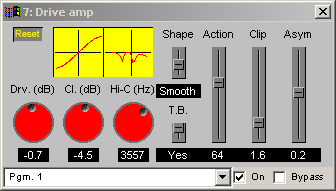'Guitar Amplifier' Guitar Fx VST Plugin
This Fx simulates some of the characteristics of a valve guitar amplifier - though not any particular valve amplifier.
The effects of a valve amplifier on a signal can be very complex, but some of the main 'first order' effects are non-linearity (caused by the
low feedback valve amplifier stages), and a 'rocky' frequency response (caused by the loudspeaker unit). In contrast to a hi-fi amplifier and
speaker system which tries not to alter the sound at all, part of the 'electric guitar sound' is the colouration produced by the
amplifier and loudspeakers.
It is wrong however to say this cannot be simulated - it all depends how hard you try. You can always distort and remove information from
a pure incoming signal, but it may be impossible to go the other way round due to information already lost.
Transistor amplifiers are usually very linear right up to the point where they completely clip the signal. That clipping is a very objectionable sound,
partly due to the harmonics suddenly added, and partly because a low level high frequency signal superimposed on a high level (clipping)
low frequency signal keeps getting completely turned on and off as the signal goes in and out of clipping. A guitar is a high dynamic
range signal, and it is essential to keep it well away from clipping at all times.
In contrast, a valve amplifier gently rounds off the signal more and more as it gets larger and larger - it does not suddenly 'clip'.
As well as that transistor amplifiers can sound 'thin'. That is because those harmonics gently added to the valve output by the non-linarity
cause a 'fat' or 'warm' sound. Without those, the transister output sounds weak.
This effect produces a settable non-linearity to try to simulate this valve amplifier effect.
As well as that, most guitar loudspeakers do not have flat frequency responses - they have peaks and troughs causes by resonances in the cone
and also due to the high amplifier output impedance which reduces damping. (The limited cone excursion caused by the surround also adds to nonlinearity.)
This effect also therefore has several settable frequency responses.
 |
The non-linearity and frequency response are settable is various ways: Non-linearity is controlled by clip and asym and visible
on the left graph. The higher the clip value the more linear it is, followed by a sudden clip. Asym allows positive and negative
signals to be treated differently (this adds even harmonics, symmetrical clipping added odd harmonics). The frequency
response has several base shapes to choose from, and 'action' controls how flat or peaky they are (see right hand graph).
As well as that, 'TB' (top boost) adds a strong treble response to everything.
Drv. controls the input gain to the non-linear clipper. Cl. controls the output level the clipper aims for. At 0dB that is a VST signal
level of +/-1.0, at -6dB it would be +/-0.5. Finally the Hi-C control is an overall final stage hi-cut filter to reduce some harmonics
produced by the clipper.
In this case the signal can be seen to be asymmetrically non-linear, limited to a level 4.5dB below +/-1.0, with a fairly peaky frequency response and a cut off at 3557Hz.
Top boost is also on.
|
Specification:
| Interface |
VST 2.4 |
| Inputs |
1 |
| Outputs |
1 |
| Programs |
4 |
| MIDI I/P 'program' supported? |
Yes |
| MIDI I/P 'control'? |
No |
(c) Nightshade Arts 2008
Contact us
Back to home page
